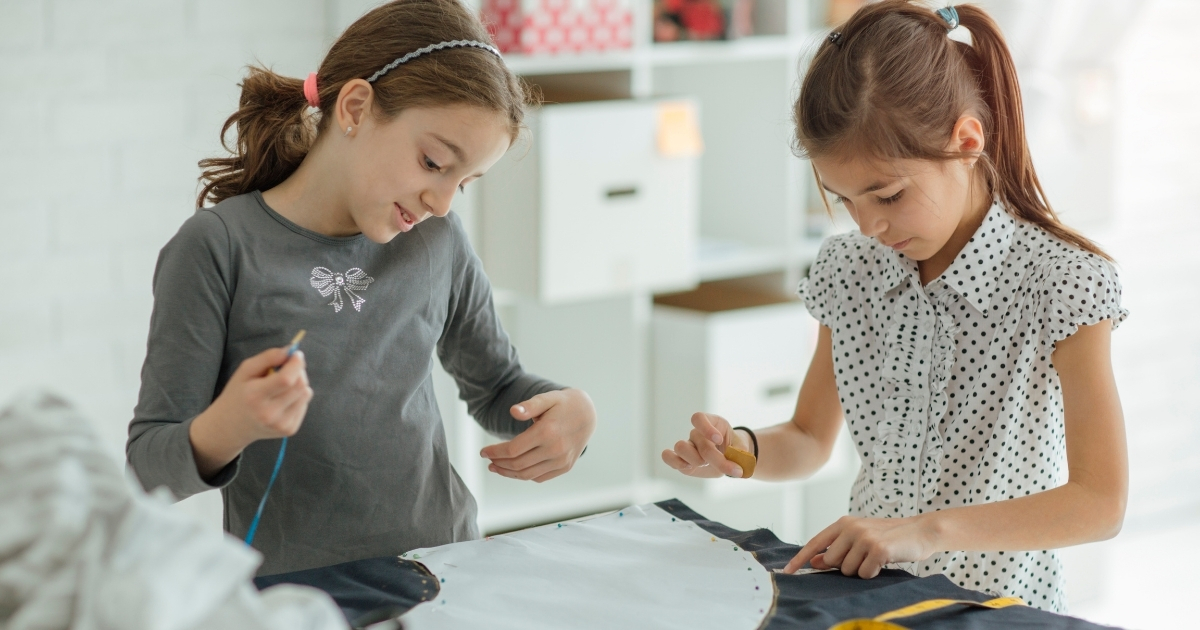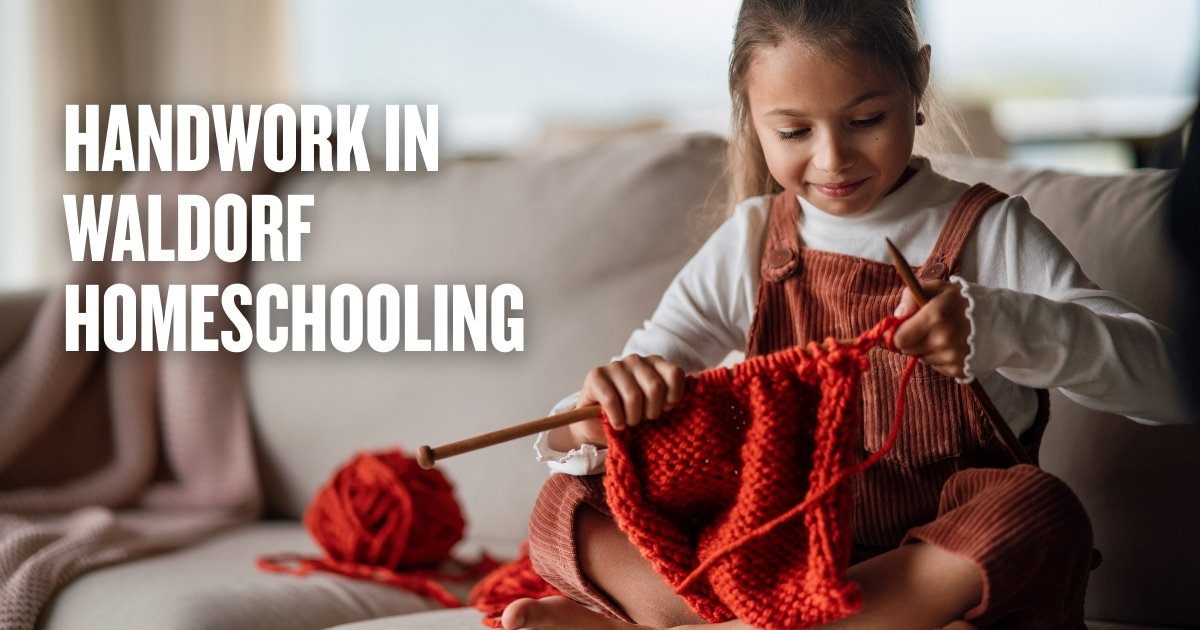Waldorf education emphasizes the integration of creativity, practical skills, and academics. Handwork activities not only nurture a child’s creativity but also strengthen their cognitive and motor skills. For homeschooling families, incorporating Waldorf handwork activities provides both structure and joy in hands-on learning. Knitting and sewing, in particular, are foundational skills that fit seamlessly into the Waldorf homeschooling philosophy.
Below, we explore how to incorporate knitting and sewing into your homeschooling routine while blending them with the principles of Waldorf education.
Why Handwork Matters In Waldorf Homeschooling
Rooted in the educational philosophy of Rudolf Steiner, Waldorf homeschooling values a holistic approach to learning, focusing on the head (intellectual development), heart (emotional development), and hands (practical skills). Handwork, such as knitting and sewing, plays a significant role by allowing children to work with their hands and develop skills that go beyond traditional academics. Here are a few reasons why handwork is essential:
- Develops Fine Motor Skills: Activities like knitting and sewing require precision and control, helping children build dexterity.
- Teaches Focus and Patience: Both crafts require children to concentrate and persevere, instilling valuable life skills.
- Promotes Creativity: From choosing colors and patterns to creating finished projects, kids experience the joy of bringing their ideas to life.
- Connects to Practical Living: Handwork teaches real-world skills, such as repairing clothes or crafting gifts.
- Fosters a Sense of Accomplishment: Completing a handwork project builds confidence and a sense of pride in one’s abilities.
By making handwork a central part of your homeschooling routine, you can support your child’s personal growth while keeping their learning process engaging and productive.
Getting Started With Knitting In Waldorf Homeschooling
Knitting is one of the most iconic handwork activities in Waldorf education. Suitable for children as young as six or seven, it introduces them to rhythm, precision, and creativity while reinforcing math and problem-solving skills. Here’s how to bring knitting into your homeschooling routine:
Selecting Materials for Beginners
Start by choosing the right materials to ensure a positive and frustration-free experience:
- Needles:
-
- Use wooden or bamboo needles for their natural grip and warmth. They are less slippery than metal or plastic.
-
- Opt for larger sizes, such as US size 8 (5mm), to make it easier for small hands to handle.
- Yarn:
-
- Choose natural fibers, such as wool or cotton, which align with Waldorf principles.
-
- Heavier-weight yarns like worsted or chunky are ideal for beginners since they’re easier to see and work with.
Teaching Knitting Basics
Patience is key when teaching children to knit. Focus on foundational skills and provide plenty of time for practice:
1. Finger Knitting:
- Begin with finger knitting for younger children. It’s a simple introduction to the concept of looping yarn and helps develop muscle memory.
2. Casting On:
- Teach children the long-tail cast-on method. Demonstrate slowly and guide their hands, if needed.
3. Simple Stitches:
- Start with the basic knit stitch. Show them how to hold the needles and guide the yarn while maintaining a loose tension.
4. Rhythm Activities:
- Incorporate rhymes or songs, such as “under the fence, catch the sheep, back we come, off we leap,” to make the process fun and memorable.
5. Practice Projects:
- Encourage practice with small projects like coasters, small scarves for dolls, or potholders before moving to larger projects.

Knitting Projects for Homeschoolers
Once your child is comfortable with knitting basics, introduce projects that match their skill level. Use these ideas to spark inspiration:
- Beginner Projects:
-
- Simple washcloths or dishcloths
-
- Toy snakes (knit a simple tube)
-
- Bookmarks
- Intermediate Projects:
-
- Children’s scarves and hats
-
- Small pouches with button closures
-
- Doll clothes
- Advanced Projects:
-
- Colorwork designs with simple patterns
-
- Stuffed animals or character toys
-
- Multi-piece garments like sweaters or vests
Knitting can easily become a meditative, calming activity in your homeschool schedule. It’s an accessible skill that grows with your child and offers endless opportunities for creative expression.
Sewing Projects For Waldorf Homeschoolers
Beyond knitting, sewing is another valuable handwork skill that builds creativity and independence. It allows children to create functional and decorative items while understanding the basics of fabrics and stitching. Sewing aligns with Waldorf principles by encouraging beauty, simplicity, and respect for materials in everyday life.
Materials and Tools for Sewing with Kids
Providing the right tools for young learners makes sewing approachable and safe:
- Needles:
-
- Use embroidery or tapestry needles with blunt tips for safety.
- Thread:
-
- Choose thick, colorful embroidery thread or pearl cotton, which is easier to handle.
- Fabric:
-
- Opt for soft, natural fabrics like cotton or felt. Felt is especially good for beginners as it doesn’t fray or require hemming.
- Additional Essentials:
-
- Small scissors with rounded tips
-
- Embroidery hoops for stretching fabric while sewing
-
- Fabric markers or chalk for tracing patterns
How to Introduce Sewing to Your Homeschool
Start by teaching your child basic sewing techniques, gradually building their confidence:
1. Threading the Needle:
- Show them how to thread and knot the needle. You can use pre-threaded needles for younger kids to make the process smoother.
2. Basic Stitches:
- Begin with simple stitches like running stitches and overcast stitches. Demonstrate how to keep even spacing and depth.
3. Using Patterns:
- Guide children in tracing patterns onto fabric, then cutting and sewing their designs.
4. Practice Pieces:
- Provide scraps of fabric for practice. Encourage them to “sew without a goal” to build comfort.
Simple Sewing Projects for Every Skill Level
Once your child is familiar with basic stitches, introduce projects that align with their abilities:
- Beginner Projects:
-
- Felt coasters or bookmarks
-
- Stuffed shapes (hearts, stars, etc.) filled with wool
-
- Simple sachets for lavender or other dried herbs
- Intermediate Projects:
-
- Fabric pouches or small tote bags
-
- Napkins or placemats with decorative edges
-
- Pillowcases with buttons or simple embroidery
- Advanced Projects:
-
- Doll clothes with small details
-
- DIY clothing repairs and hemming
-
- Personalized quilt squares
Sewing provides practical skills and nurtures artistic expression. By starting with manageable projects, your child will gradually gain confidence to tackle more complex creations.
Integrating Handwork Into Your Homeschool Curriculum
While knitting and sewing are wonderful handwork activities on their own, incorporating them into your homeschool curriculum can deepen your child’s learning experience. Here’s how to integrate handwork into other subjects and rhythms of your homeschool day:
- Math: Use knitting and sewing projects to teach counting, patterns, and geometry (e.g., calculating dimensions for fabric pieces or stitch patterns).
- Art: Encourage design and color theory by having children select materials and plan their projects.
- History: Explore the history of textiles, knitting, and sewing in different cultures. Your child could create projects inspired by traditional techniques or patterns.
- Storytelling: Involve knitting or sewing during read-aloud sessions. This helps children internalize stories while engaging their hands.
- Seasonal Themes: Create projects that align with seasonal celebrations in Waldorf homeschooling (e.g., knit wool ornaments for winter or sew seed pouches for spring gardening).
Flexibility is key when incorporating handwork into your schedule. Some families may dedicate a specific day of the week to handwork, while others weave it into daily activities as a break from academic lessons.
Supporting Creativity and Independence
Knitting and sewing instill not only practical skills but also a sense of creativity and independence. When children are encouraged to work with their hands, they learn to problem-solve, express themselves, and take pride in their accomplishments. Over time, they gain an appreciation for the value of handmade work and develop a deeper connection to the materials and processes that shape our world.
By fostering an environment where handwork is cherished and celebrated, you’ll create a rhythm in your homeschool that allows your child to thrive. Whether they’re knitting a scarf or sewing a doll’s dress, the lessons learned through Waldorf handwork activities will remain with them for a lifetime.



